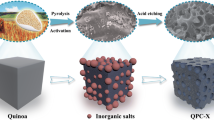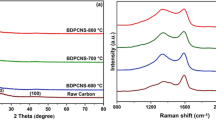Abstract
Biomass-derived carbon materials are often applied in green energy storage systems like supercapacitors due to the abundance, facile access, low cost and nontoxicity. In this work, biomass-derived porous carbon spheres (PCSs) have been prepared by the carbonization and etching of sodium alginate (SA). Using polyacrylic acid (PAA) as a template, N-doped graphene quantum dots (N-GQDs) are grown evenly on the surface of the PCSs, which drastically improves the pseudocapacitive activity and electrical conductivity. The prepared N-GQD/PCS/PAA electrode has a remarkable specific capacitance of 419.3 F g−1 at 1 A g−1. The symmetric supercapacitor assembled with N-GQD/PCS/PAA electrode exhibits a great specific capacitance of 337.5 F g−1 at 0.5 A g−1. Particularly, the device displays an ultrafast charge/discharge rate of 2.5 V s−1, demonstrating excellent rate capability and structural stability. The supercapacitor based on N-GQD/PCS/PAA possesses high energy density of 11.72 W h kg−1 and excellent cycle stability. A high mass loading (9.18 mg cm−2) with the energy density of 8.54 W h kg−1 is also investigated to realize the practical application for the device. In general, a novel biomass-derived carbon electrode modified with highly electrochemical active N-doped graphene quantum dots has been constructed to provide an effective way for high performance energy storage.











Similar content being viewed by others
References
Chai D, Gómez-García CJ, Li B, Pang H, Ma H, Wang X, Tan L (2019) Polyoxometalate-based metal-organic frameworks for boosting electrochemical capacitor performance. Chem Eng J 373:587–597. https://doi.org/10.1016/j.cej.2019.05.084
Jeyaranjan A, Sakthivel TS, Neal CJ, Seal S (2019) Scalable ternary hierarchical microspheres composed of PANI/ rGO/CeO2 for high performance supercapacitor applications. Carbon 151:192–202. https://doi.org/10.1016/j.carbon.2019.05.043
Pawar SA, Kim D, Lee R, Kang S-W, Patil DS, Kim TW, Shin JC (2019) Efficient supercapacitor based on polymorphic structure of 1T′-Mo6Te6 nanoplates and few-atomic-layered 2H-MoTe2: A layer by layer study on nickel foam. Chem Eng J 371:182–192. https://doi.org/10.1016/j.cej.2019.04.009
Wei J, Luo C, Li H, Lv W, Liang J, Deng Y, Huang Z, Wang C, Kang F, Yang Q-H (2019) Direct assembly of micron-size porous graphene spheres with a high density as supercapacitor materials. Carbon 149:492–498. https://doi.org/10.1016/j.carbon.2019.04.071
Lv S, Ma L, Shen X, Tong H (2020) Recent design and control of carbon materials for supercapacitors. J Mater Sci 56(3):1919–1942. https://doi.org/10.1007/s10853-020-05351-6
Zhai T, Sun S, Liu X, Liang C, Wang G, Xia H (2018) Achieving insertion-like capacity at ultrahigh rate via tunable surface pseudocapacitance. Adv Mater 30(12):e1706640. https://doi.org/10.1002/adma.201706640
Zhao H, Liu L, Fang Y, Vellacheri R, Lei Y (2018) Nickel nanopore arrays as promising current collectors for constructing solid-state supercapacitors with ultrahigh rate performance. Front Chem Sci Eng 12(3):339–345. https://doi.org/10.1007/s11705-018-1699-6
Zhong Y, Shi T, Huang Y, Cheng S, Liao G, Tang Z (2018) One-step synthesis of porous carbon derived from starch for all-carbon binder-free high-rate supercapacitor. Electrochim Acta 269:676–685. https://doi.org/10.1016/j.electacta.2018.03.012
Liu Z, Wu ZS, Yang S, Dong R, Feng X, Mullen K (2016) Ultraflexible in-plane micro-supercapacitors by direct printing of solution-processable electrochemically exfoliated graphene. Adv Mater 28(11):2217–2222. https://doi.org/10.1002/adma.201505304
Sun G, Zhang X, Lin R, Chen B, Zheng L, Huang X, Huang L, Huang W, Zhang H, Chen P (2016) Weavable, high-performance, solid-state supercapacitors based on hybrid fibers made of sandwiched structure of MWCNT/rGO/MWCNT. Adv Electron Mater 2(7):1600102. https://doi.org/10.1002/aelm.201600102
Lv Q, Chi K, Zhang Y, Xiao F, Xiao J, Wang S, Loh KP (2017) Ultrafast charge/discharge solid-state thin-film supercapacitors via regulating the microstructure of transition-metal-oxide. J Mater Chem A 5(6):2759–2767. https://doi.org/10.1039/c6ta09849e
Wang K, Song Y, Yan R, Zhao N, Tian X, Li X, Guo Q, Liu Z (2017) High capacitive performance of hollow activated carbon fibers derived from willow catkins. Appl Surf Sci 394:569–577. https://doi.org/10.1016/j.apsusc.2016.10.161
Xu M, Yu Q, Liu Z, Lv J, Lian S, Hu B, Mai L, Zhou L (2018) Tailoring porous carbon spheres for supercapacitors. Nanoscale 10(46):21604–21616. https://doi.org/10.1039/c8nr07560c
Wang D, Lu Z, Xu L (2020) Microstructure design of porous nanocarbons for ultrahigh-energy and power density supercapacitors in ionic liquid electrolyte. J Mater Sci 55(17):7477–7491. https://doi.org/10.1007/s10853-020-04538-1
Song M, Zhou Y, Ren X, Wan J, Du Y, Wu G, Ma F (2019) Biowaste-based porous carbon for supercapacitor: The influence of preparation processes on structure and performance. J Colloid Interface Sci 535:276–286. https://doi.org/10.1016/j.jcis.2018.09.055
Wang Q, Zhang Y, Jiang H, Meng C (2019) In-situ grown manganese silicate from biomass-derived heteroatom-doped porous carbon for supercapacitors with high performance. J Colloid Interf Sci 534:142–155. https://doi.org/10.1016/j.jcis.2018.09.026
Gao K, Niu Q, Tang Q, Guo Y, Wang L (2017) Graphene-like 2D porous carbon nanosheets derived from cornstalk pith for energy storage materials. J Electron Mater 47(1):337–346. https://doi.org/10.1007/s11664-017-5771-7
Thakur AK, Choudhary RB, Majumder M, Gupta G (2017) In-situ integration of waste coconut shell derived activated carbon/polypyrrole/rare earth metal oxide (Eu2O3): a novel step towards ultrahigh volumetric capacitance. Electrochim Acta 251:532–545. https://doi.org/10.1016/j.electacta.2017.08.159
Zhang Q, Han K, Li S, Li M, Li J, Ren K (2018) Synthesis of garlic skin-derived 3D hierarchical porous carbon for high-performance supercapacitors. Nanoscale 10(5):2427–2437. https://doi.org/10.1039/c7nr07158b
He D, Zhao W, Li P, Liu Z, Wu H, Liu L, Han K, Liu L, Wan Q, Butt FK, Qu X (2019) Bifunctional biomass-derived 3D nitrogen-doped porous carbon for oxygen reduction reaction and solid-state supercapacitor. Appl Surf Sci 465:303–312. https://doi.org/10.1016/j.apsusc.2018.09.185
Ye Z, Wang F, Jia C, Mu K, Yu M, Lv Y, Shao Z (2017) Nitrogen and oxygen-codoped carbon nanospheres for excellent specific capacitance and cyclic stability supercapacitor electrodes. Chem Eng J 330:1166–1173. https://doi.org/10.1016/j.cej.2017.08.070
Cui Y, Wang H, Xu X, Lv Y, Shi J, Liu W, Chen S, Wang X (2018) Nitrogen-doped porous carbons derived from a natural polysaccharide for multiple energy storage devices. Sustain Energ Fuels 2(2):381–391. https://doi.org/10.1039/c7se00443e
Raymundo-Piñero E, Leroux F, Béguin F (2006) A high-performance carbon for supercapacitors obtained by carbonization of a seaweed biopolymer. Adv Mater 18(14):1877–1882. https://doi.org/10.1002/adma.200501905
Bai Q, Xiong Q, Li C, Shen Y, Uyama H (2018) Hierarchical porous carbons from a sodium alginate/bacterial cellulose composite for high-performance supercapacitor electrodes. Appl Surf Sci 455:795–807. https://doi.org/10.1016/j.apsusc.2018.05.006
Huang H, Zeng X, Li W, Wang H, Wang Q, Yang Y (2014) Reinforced conducting hydrogels prepared from the in situ polymerization of aniline in an aqueous solution of sodium alginate. J Mater Chem A 2(39):16516–16522. https://doi.org/10.1039/c4ta03332a
Li J, Sun K, Leng C, Jiang J (2018) Zipping assembly of an Fe3O4/carbon nanosheet composite as a high-performance supercapacitor electrode material. RSC Adv 8(65):37417–37423. https://doi.org/10.1039/c8ra06970k
Wang N, Liu Q, Kang D, Gu J, Zhang W, Zhang D (2016) Facile self-cross-linking synthesis of 3D nanoporous Co3O4/carbon hybrid electrode materials for supercapacitors. ACS Appl Mater Interf 8(25):16035–16044. https://doi.org/10.1021/acsami.6b03527
Xuan C, Peng Z, Wang J, Lei W, Xia K, Wu Z, Xiao W, Wang D (2017) Biomass derived nitrogen doped carbon with porous architecture as efficient electrode materials for supercapacitors. Chinese Chem Lett 28(12):2227–2230. https://doi.org/10.1016/j.cclet.2017.09.009
Jia H, Cai Y, Lin J, Liang H, Qi J, Cao J, Feng J, Fei W (2018) Heterostructural graphene quantum dot/MnO2 nanosheets toward high-potential window electrodes for high-performance supercapacitors. Adv Sci (Weinh) 5(5):1700887. https://doi.org/10.1002/advs.201700887
Zhang Q, Wang N, Zhao P, Yao M, Hu W (2018) N-doped mesoporous carbon integrated on carbon cloth for flexible supercapacitors with remarkable performance. J Mater Sci 53(20):14573–14585. https://doi.org/10.1007/s10853-018-2654-0
Dong X, Xu Y, Wang S, Zhao J, Ren B, Zhang L, Liu Z (2018) Design of high specific surface area N-doped carbon aerogels via a microwave reduction method. J Mater Sci 54(2):1580–1592. https://doi.org/10.1007/s10853-018-2909-9
Li Z, Bu F, Wei J, Yao W, Wang L, Chen Z, Pan D, Wu M (2018) Boosting the energy storage densities of supercapacitors by incorporating N-doped graphene quantum dots into cubic porous carbon. Nanoscale 10(48):22871–22883. https://doi.org/10.1039/c8nr06986g
Kongkaew S, Kanatharana P, Thavarungkul P, Limbut W (2017) A preparation of homogeneous distribution of palladium nanoparticle on poly (acrylic acid)-functionalized graphene oxide modified electrode for formalin oxidation. Electrochim Acta 247:229–240. https://doi.org/10.1016/j.electacta.2017.06.131
Guo Y, Zhou X, Tang Q, Bao H, Wang G, Saha P (2016) A self-healable and easily recyclable supramolecular hydrogel electrolyte for flexible supercapacitors. J Mater Chem A 4(22):8769–8776. https://doi.org/10.1039/c6ta01441k
Ye Z, Wang F, Jia C, Shao Z (2018) Biomass-based O, N-codoped activated carbon aerogels with ultramicropores for supercapacitors. J Mater Sci 53(17):12374–12387. https://doi.org/10.1007/s10853-018-2487-x
Wang L, Wang Y, Xu T, Liao H, Yao C, Liu Y, Li Z, Chen Z, Pan D, Sun L, Wu M (2014) Gram-scale synthesis of single-crystalline graphene quantum dots with superior optical properties. Nat Commun 5:5357. https://doi.org/10.1038/ncomms6357
Iamprasertkun P, Krittayavathananon A, Sawangphruk M (2016) N-doped reduced graphene oxide aerogel coated on carboxyl-modified carbon fiber paper for high-performance ionic-liquid supercapacitors. Carbon 102:455–461. https://doi.org/10.1016/j.carbon.2015.12.092
Wang N, Zhao P, Liang K, Yao M, Yang Y, Hu W (2017) CVD-grown polypyrrole nanofilms on highly mesoporous structure MnO2 for high performance asymmetric supercapacitors. Chem Eng J 307:105–112. https://doi.org/10.1016/j.cej.2016.08.074
Cao F, Zhao M, Yu Y, Chen B, Huang Y, Yang J, Cao X, Lu Q, Zhang X, Zhang Z, Tan C, Zhang H (2016) Synthesis of two-dimensional CoS1.097/nitrogen-doped carbon nanocomposites using metal-organic framework nanosheets as precursors for supercapacitor application. J Am Chem Soc 138(22):6924–6927. https://doi.org/10.1021/jacs.6b02540
Lai F, Miao YE, Zuo L, Lu H, Huang Y, Liu T (2016) Biomass-derived nitrogen-doped carbon nanofiber network: a facile template for decoration of ultrathin nickel-cobalt layered double hydroxide nanosheets as high-performance asymmetric supercapacitor electrode. Small 12(24):3235–3244. https://doi.org/10.1002/smll.201600412
de Oliveira HP, Sydlik SA, Swager TM (2013) Supercapacitors from free-standing polypyrrole/graphene nanocomposites. J Phys Chem C 117(20):10270–10276. https://doi.org/10.1021/jp400344u
Li Z, Liu X, Wang L, Bu F, Wei J, Pan D, Wu M (2018) Hierarchical 3D all-carbon composite structure modified with n-doped graphene quantum dots for high-performance flexible supercapacitors. Small 14(39):1801498. https://doi.org/10.1002/smll.201801498
Li Z, Wei J, Ren J, Wu X, Wang L, Pan D, Wu M (2019) Hierarchical construction of high-performance all-carbon flexible fiber supercapacitors with graphene hydrogel and nitrogen-doped graphene quantum dots. Carbon 154:410–419. https://doi.org/10.1016/j.carbon.2019.08.040
Zhang C, Liu X, Li Z, Zhang C, Chen Z, Pan D, Wu M (2021) Nitrogen-doped accordion-like soft carbon anodes with exposed hierarchical pores for advanced potassium-ion hybrid capacitors. Adv Func Mater 31(23):2101470. https://doi.org/10.1002/adfm.202101470
Liu J, Wang J, Xu C, Jiang H, Li C, Zhang L, Lin J, Shen Z (2018) Advanced energy storage devices: basic principles, analytical methods, and rational materials design. Adv Sci 5(1):1700322. https://doi.org/10.1002/advs.201700322
Hu J, Wang H, Gao Q, Guo H (2010) Porous carbons prepared by using metal–organic framework as the precursor for supercapacitors. Carbon 48(12):3599–3606. https://doi.org/10.1016/j.carbon.2010.06.008
Kwak M-J, Ramadoss A, Yoon K-Y, Park J, Thiyagarajan P, Jang J-H (2017) Single-step synthesis of N-doped three-dimensional graphitic foams for high-performance supercapacitors. ACS Sust Chem Eng 5(8):6950–6957. https://doi.org/10.1021/acssuschemeng.7b01132
Acknowledgements
This research was supplied by National Natural Science Foundation of China (Nos. 11975148, 12075147), and Program for Changjiang Scholars and Innovative Research Team in University (No. IRT13078).
Author information
Authors and Affiliations
Corresponding author
Ethics declarations
Conflict of interest
The authors declare that they have no conflict of interest.
Additional information
Handling Editor: Kyle Brinkman.
Publisher's Note
Springer Nature remains neutral with regard to jurisdictional claims in published maps and institutional affiliations.
Rights and permissions
About this article
Cite this article
Bu, J., Zhou, Z., Wu, X. et al. Nitrogen-doped biomass-derived porous carbon spheres for supercapacitors with ultrafast charge/discharge rate up to 2.5 V s−1. J Mater Sci 56, 17694–17708 (2021). https://doi.org/10.1007/s10853-021-06389-w
Received:
Accepted:
Published:
Issue Date:
DOI: https://doi.org/10.1007/s10853-021-06389-w




